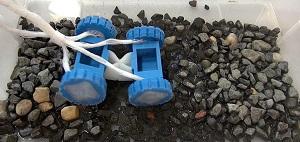Rutgers University is New Jersey's own state university in the United States. The university's Department of Mechanical and Aerospace Engineering have shown off their new squishy robot. Yes, you read that right. To be more specific, the robot is considered to be a pneumatically driven elastomeric structure robot. The researchers have used the recent bendable robot technology to create a new robot that could have a host of applications in future industries where bendable, 'squishy' robots might be needed.
 Credit: Rutgers University
Credit: Rutgers University
Bendable elements on robots are not a new innovation. They have been used in deep-sea coral expeditions for the purpose of handling coral with care, due to conventional robotic arms being too forceful. However, now the Rutgers researchers want to grow the innovation of soft robotics. The uses could range from sending the robots into rocky mountains or even driving the robots on different planets. The bendable, flexible material could be invaluable due to its ability to get through terrain that conventional robotics would not be able to do. See the video below to see how the robot navigates rocky terrain.
"If you build a robot or vehicle with hard components, you have to have many sophisticated joins so the whole body can handle complex or rocky terrain. For us, the whole design is very simple, but it works very well because the whole body is soft and can negotiate complex terrain," said Xiangyu Gong, an alumnus of Rutgers University in the mechanical engineering department.
The researchers used silicone rubber to build a wheel and axle assembly and used motors that are engineered to be devoid of metal. On top of that, the researchers had to assemble the vehicle to ensure its safety should it survive some sort of impact.
The team used 3D printers to print the rotors they used. As a result, the researchers were able to create 'squishy' pneumatic internal and external rotors. The external rotors were able to be used as wheels that the researchers used to design a four-wheeled rover robot.
"With no metal components and moisture-sensitive electronics on the vehicle itself, the vehicle is equipped with the actuators. [The rotors] function not only in a dry environment but also underwater as an amphibious vehicle," the researchers said. The researchers also showed that the robot could be dropped from eight times its height and survive the fall.
